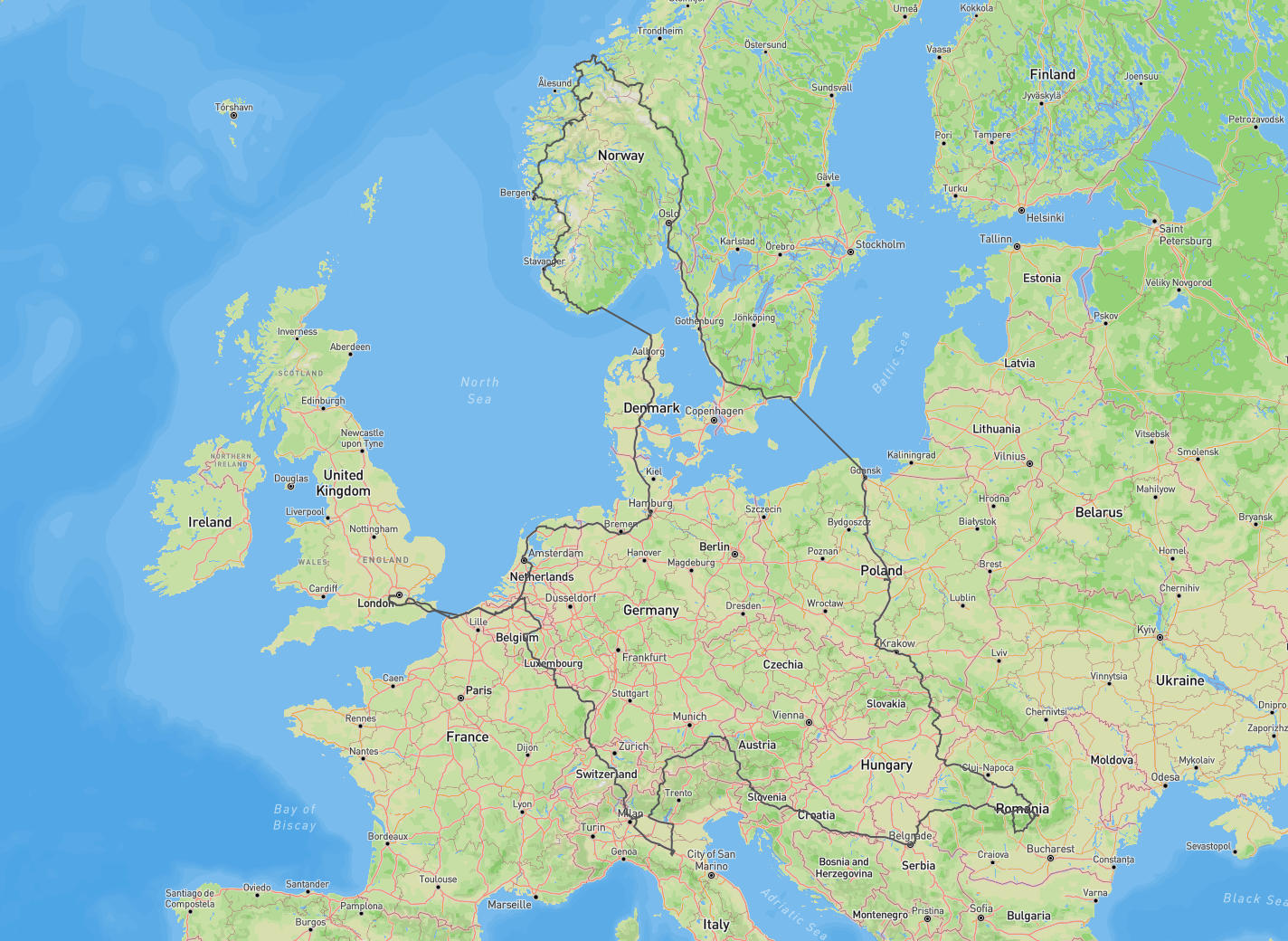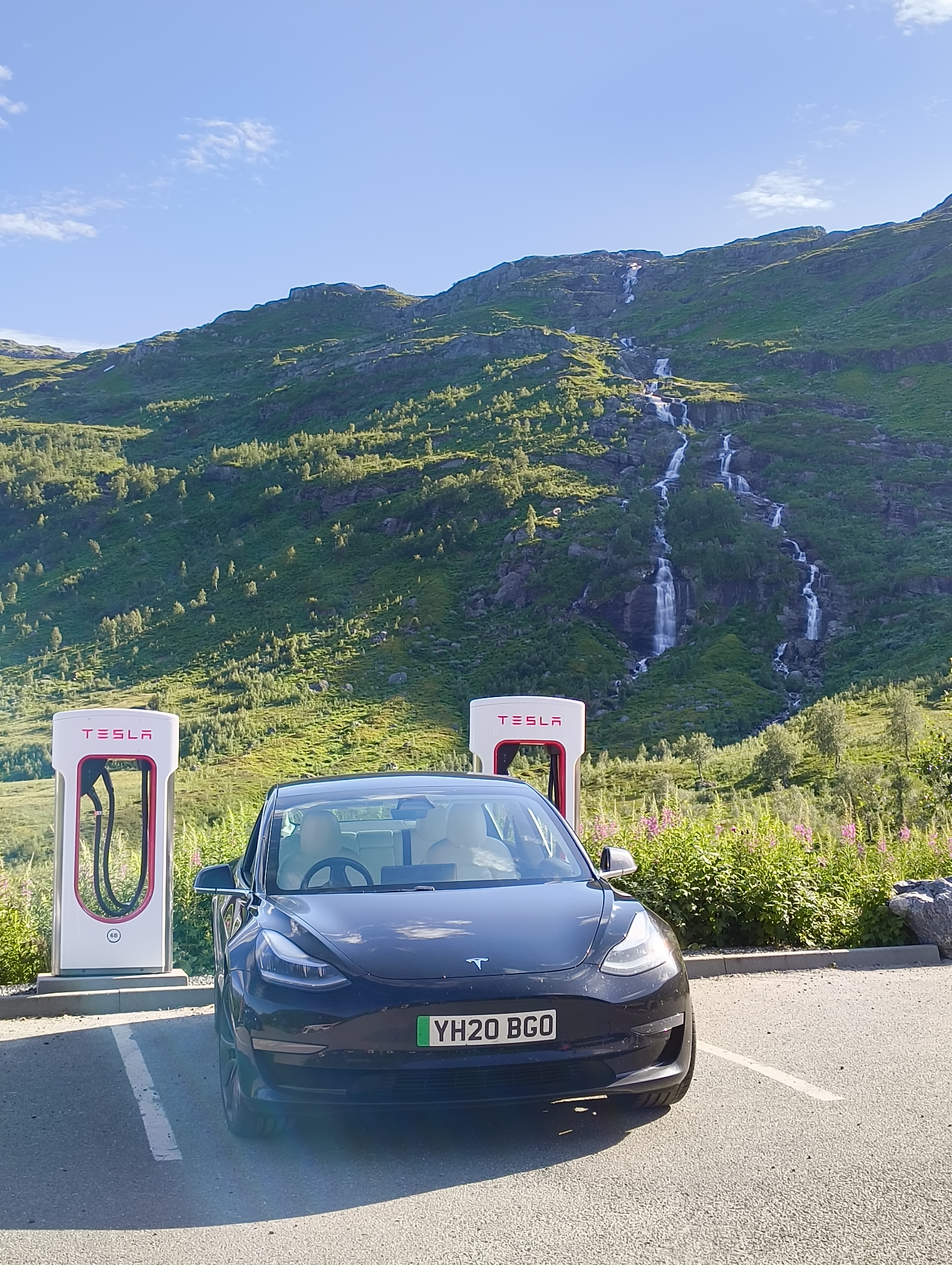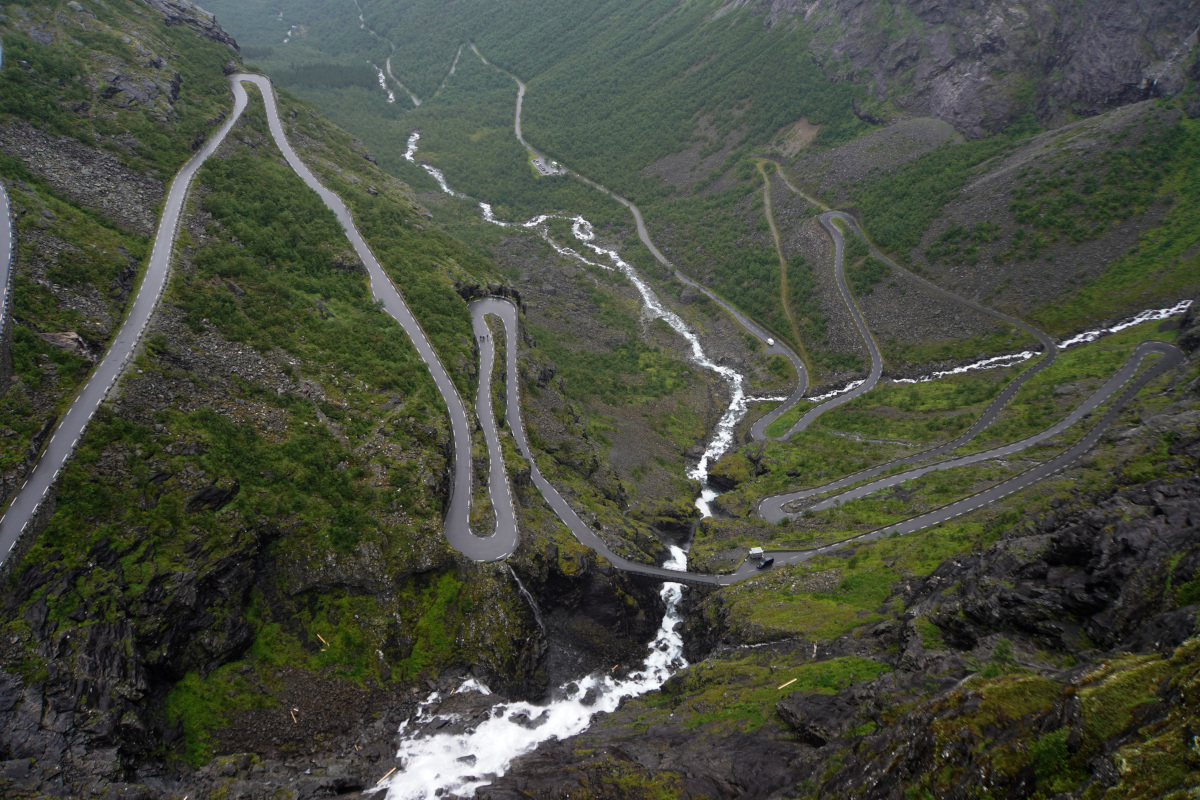Beyond Range Anxiety: Conquering Europe in an EV
September 29, 2024
I’ve always had a particular fondness for a good road trip. From motoring up the Pacific Coast Highway in a American muscle car to meandering through the misty Scottish Highlands, there’s an undeniable allure to exploring the world on four wheels. In recent years, my adventures have taken a decidedly electric turn. I’ve traversed the verdant hills of Ireland and ventured across various European countries, all without so much as a drop of petrol.
As an enthusiast of long-distance motoring, it’s been rather fascinating to witness the rapid evolution of EV infrastructure. What once required meticulous planning and occasional bouts of range anxiety has transformed into an increasingly seamless experience. Each subsequent journey has proven more straightforward than the last, with charging stations materialising in the most unexpected locales.
This summer, finding myself with an abundance of time and a growing confidence in the EV network, I decided to embark upon my most ambitious journey to date: a 10,000km electric odyssey around Europe. This blog serves as a chronicle of that adventure - the triumphs, the challenges, and everything in between. It stands as a testament to the remarkable progress in the realm of electric travel and offers a glimpse into the future of long-distance motoring.
So, make yourself comfortable as we set off on this electrifying journey across the continent. It promises to be quite the adventure.
The Trip Overview
Our route took us from London, across the ferry to France, then swiftly up through The Netherlands into Denmark. We hopped on another ferry to the southern tip of Norway, then slowed down for a scenic drive up the fjords. After 1,250km up the west coast to Kristiansund, we turned back to head into Sweden via Oslo, then onto a ferry to western Poland. We journeyed down through Poland and into Romania, where we spent some time exploring Transylvania at the easternmost point of our trip. Heading west, we traveled through Serbia and Croatia into the Alps region, visiting friends in Austria and northern Italy. The final leg took us up to Luxembourg and back on a ferry from France to the UK. In total, we covered just over 10,000 km.

Choosing the Car
For this ambitious journey, we needed a vehicle that could withstand the rigours of diverse European terrain while offering ample range and performance. Our choice landed on a 4-year-old Tesla Model 3 Performance.
This particular car had already clocked an impressive 100,000km, likely as a motorway commuter in its previous life. Despite its mileage, the vehicle showed minimal signs of wear, with battery degradation at a mere 3% - a testament to the longevity of modern EV technology and a direct challenge to the common misconception that electric car batteries rapidly deteriorate.
Our reasons for selecting this model were manifold:
- Range: The Performance variant boasted a larger battery capacity, crucial for our long-distance adventure.
- Efficiency: It has both a smaller battery and much longer range than my previous Audi e-tron. Meaning, it’s quicker and cheaper to charge, with lower emissions.
- Charging Network: Tesla’s extensive Supercharger infrastructure across Europe provided reassurance for our journey.
- Performance: We desired a vehicle that could tackle mountain passes and winding roads with a bit of fun.
- Value: A used model offered an excellent balance of features and cost-effectiveness.
From the smooth motorways of Norway to the rugged tracks of rural Romania, this well-travelled Tesla did us well (apart from when the windscreen got cracked by a flicked up bolt in Hungary 😢). Our choice of a used EV for such an extensive trip wasn’t just economical; it was a statement about the reliability and durability of electric vehicles, even after significant use.
Charging Experience: The Good Stuff!
The short version of this blog post is that the charging was fine. We never ran out of battery; we never even got close. And, while we’re talking about things that didn’t happen: the battery didn’t need replacing, the car never set itself on fire, and we didn’t spend hours waiting around for it to charge.
Mostly, we jumped in the car each day, plugged the day’s itinerary and the evening’s accommodation into the navigation, and let it tell us if we needed to charge en route. If we did, it would direct us via a supercharger. Sometimes even Superchargers with amazing views!

The even better experience was when we arrived at hotels, spotted a free EV charger in their parking, and filled up overnight while we slept. This happened multiple times in places where we least expected it. One particular surprise was a very low-budget hotel in Oradea, Romania, where not only did they have a free-to-use charger, but it was hooked up to their solar installation for fully green charging.
Cost and Energy Usage
The total energy usage was a staggering 1.9 MWh of electricity. For context, that’s approximately equal to 8 months of my typical home energy usage - so, a lot of electricity.
But, let’s compare that to other methods of travel. 85% of that charging was done using Tesla Superchargers, which Tesla say use 100% renewable energy. But, let’s be skeptical and use an average grid emissions of 0.3kg of CO2e per kWh[1] for all of the energy used.
1900kWh * 0.3 kg = 570 kg = 0.570 tonnes of CO2e for all the energy used.
Comparing this to a very short flight, London Heathrow to Dublin, Ireland: One economy round-trip flight would be 0.420 tonnes. Two of us were on this trip, so both of us flying return to Dublin would have emitted more CO2. [2]
I’ve worked in this sector for a while, but I was still shocked when doing these calculations. First by how much energy was used compared to my household consumption. And, a second time by how much lower the emissions were compared to even the shortest flight. This really solidified my understanding of just how high-emission flying is, and how we need to push to electrify transportation.
Now, let’s talk about costs. The total charging costs were around £500, which averages to around £0.26 per kWh. These costs are a blend of the cheap European Tesla Superchargers and include some free use of AC chargers at hotels.
To achieve a similar cost using current fuel prices, we’d have to find an ICE car with 70+ mpg efficiency. That’s an unrealistically high efficiency for any modern car, which would typically be about half that at 35-40 mpg. Or, in other words, the charging cost about half of what petrol would have.
[1] This is just a ballpark figure. Norway typically has much lower emissions, and Poland much higher, but this seems like a good average for a rough calculation.
[2] I have ignored the ferry emissions in this calculation, but these are insignificant compared with the charging.
Lessons Learned and Room for Improvement
We encountered only two real charging issues throughout the trip. Both were fairly easy to resolve, but I wanted to share them so that we can keep improving the experience.
The first issue came after getting the ferry from Sweden to Poland. We had fully charged the car in Sweden near the port, as we’d arrived early and had some time to kill. Arriving in Gdynia, we still had a lot of charge but found the next supercharger was 200km away in Ciechocinek. That wasn’t an issue as we had the range to get there. We had grown pretty confident in the supercharger network and had no concern about arriving with very low charge in the car. We knew they would work and charge faster if the battery was low. But on the way there, we saw a symbol we’d not seen before on the navigation. The supercharger was very busy, and we’d have to wait more than 30 minutes to be able to start charging. Arriving there, it became clear this was true. At the previous supercharger in Sweden, there were 20+ stalls to charge on, and for most of the time, we were the only people there. But at Ciechocinek in Poland, there were only 4 stalls, and they were all taken. There were 4 other Teslas parked around the area, queuing for a charge, with one of the drivers helping to coordinate the queue. We had to simply wait, not wanting to risk driving to another non-Tesla charger as we’d arrive with near 0% battery and with no backup if it failed.
This is a scene that used to be common with EVs, back when there was typically only one or two chargers at a site, and cars were slow to charge. But this scene has all but disappeared thanks to the rapid expansion of the charging network. Hopefully, rapid expansion will come to northern Poland soon too.
The second issue came later in the trip in Târgu Mureș, Romania. We’d booked an Airbnb apartment, and it listed that it had an EV Charger included. When we arrived, it was a block of new build apartments, each 8+ floors tall, and at least 10 blocks. The charger was one single AC charger shared by the entire site. Thankfully, it wasn’t in use when we arrived, so we parked in the bay. A note on that charger said “Phone this number to get the card to use this charger” (we had to Google translate). We phoned the number, and after a lot of translating between Romanian and English, the security guard whose number it was came to the charger. He said that while it is his number on the note, he has no clue how to activate the charger and does not have an RFID card. So, it seems that we were out of luck. We messaged the host, and they faced the same issue. They’d never used the charger before and didn’t know how it worked. After a lot of effort trying to get it to work, we decided to give up. Thankfully, there was a Lidl shop just around the corner with a DC charger; we fully charged there instead.
Despite encountering a couple of minor hiccups, it’s crucial to emphasize that these issues were mere blips in our 10,000km journey. Each setback was resolved within 30 minutes, hardly a significant inconvenience on such an extensive trip. The overall charging experience was remarkably smooth, defying common anxieties about long-distance EV travel.
However, there’s always room for improvement. Based on our experiences, we’ve identified two key areas for enhancement:
-
Expand Ultra-Charging Networks:
- Tell more people that the Tesla Supercharger network is mostly open to any EV to use, esspecially in Europe.
- Continue aggressive expansion of fast-charging infrastructure
- Focus on strategic placement in areas with currently limited options, such as northern Poland.
- Ensure adequate capacity at popular stopover points to prevent queuing.
-
Standardize EV Amenity Descriptions:
- Platforms like Airbnb should implement stricter guidelines for hosts advertising EV charging.
- Clear definitions of what constitutes a functional EV charger are needed.
- Hosts should be required to provide specific details about charger type, power output, and accessibility.
These improvements would further streamline the EV road trip experience, making electric long-distance travel even more accessible and hassle-free. As it stands, our journey proves that the current infrastructure is already capable of supporting ambitious electric adventures across Europe.
Conclusion
Is it true that the ‘infrastructure just isn’t there yet’? No! Over 10,000km, we found an EV to be perfect for a road trip. Charging, while not perfect, is pretty close. Unlike our EV road trips a few years ago, we did barely any planning of routes and simply relied on finding chargers during our natural breaks from driving. Chargers at hotels and Airbnbs are fairly common, and you often get surprised by one that you didn’t know existed.
So, yes, the infrastructure is there, and a long EV road trip is a surprisingly low-cost and low-carbon way to travel.
Get out there and explore!
